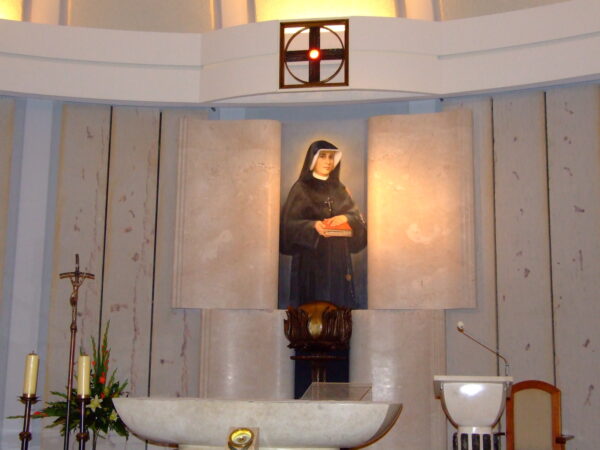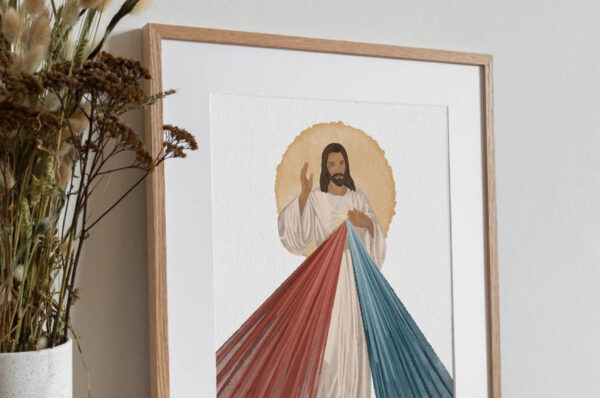This past December, my daughter was born with breathing complications, so she spent eight days in the neonatal intensive care unit. Thankfully, her life was not threatened, but I still awaited her homecoming with extreme anticipation. I felt incomplete without this child once inside me. I spent my days and nights repeatedly logging into her NICU room camera so I could watch her sleep. At Mass the Sunday after she was born, I felt the weight of my empty arms. Speaking my prayer of yearning, Christ tenderly responded with the consoling gift of his body and blood.
Fast-forward five months. My precious baby lay asleep in my arms, but my family and I were not at Mass on Sunday. Along with Catholics around the world, we watched Mass from our living room. I thought back to watching my daughter on the NICU room camera. I had been so thankful for the technology, but it was only a shadow compared to her real presence. Now, I felt the absence of the sacrament. My soul hungered for the Real Presence of Christ.
In June, our Church celebrates the Solemnity of the Body and Blood of Jesus. The feast honors the Eucharist as the very “source and summit” of our Christian life, and it could not come at a more appropriate time. Our world and our nation are desperately in need of the healing presence of Christ. As our church doors begin to open, we can finally fall to our knees in gratitude for the return to the physical presence of this super-substantial gift. Whether or not you have been able to return to Mass, here are some insights to help prepare your heart for encountering the Lord in the Eucharist once again.
Invitation to relationship
From the first pages of Scripture, God makes himself present among his people. He invites humanity into an intimate relationship with him, not just in spiritual ways, but through physical manifestations of his presence. God walks in the garden with Adam and Eve. He appears to Moses in the burning bush. After the great Exodus from slavery in Egypt, God journeys with the Israelites in the desert and gives them a visible sign of his presence: a cloud by day and pillar of fire by night. Later, God appears in Solomon’s temple as a glory cloud. And finally, in the Incarnation, the Word becomes flesh. We meet God face to face in the person of Jesus Christ and recognize our true destiny is to be united with him. As we anticipate our heavenly homeland, Christ gives us his physical presence in the Eucharist. All of salvation history led up to this point where we enter into intimacy with him through the Eucharist. St. Catherine of Siena beautifully relates: “O boundless charity! Just as you gave us yourself, wholly God and wholly human, so you left us all of yourself as food so that while we are pilgrims in this life, we might not collapse in our weariness but be strengthened by you, heavenly food” (“The Prayers of St. Catherine of Siena”).
Remembering Christ’s presence
When Jesus celebrated the Passover meal with his disciples at the Last Supper, he connected the Eucharist with Passover for good reason. Just as Passover recalls God’s saving act in history, Jesus would soon gain freedom for all mankind — past, present and future — by his death on the cross. The word “remember” literally means to “make present again,” signifying that both feasts of Passover and the Last Supper were not meant to be one-time feasts. What is remembered is celebrated in the present tense. Passover is reenacted throughout the generations because God’s saving action is personal, living and dynamic. Jewish sons are taught to ask their father, “Why is this night different from other nights?” The father then responds, “It is because of what the Lord did for me when I came out of Egypt.” The point is that suffering is real and so is God’s saving help!
Jesus’ words and actions at the Last Supper echo the Passover meal and then take it further. They fulfill the old covenant and establish the new. The Catechism of the Catholic Church shares that when the Church celebrates the Eucharist, Christ’s Passover is made present: His passion, death and resurrection are happening in front of us at every Mass (No. 1364). Once again, God’s saving action is personal, living and dynamic. And just as the Passover meal is not completed by the death of the lamb but in the eating of the lamb’s flesh, so, too, is Christ’s sacrifice not complete until we partake in his body, blood, soul and divinity in the Mass. According to St. Francis de Sales: “You cannot consider our Savior in an action more full of love or more tender than this. In it he abased himself, if we may so express it, and changes himself into food, so that he may penetrate our souls and unite most intimately to the heart and body of the faithful” (“Introduction to the Devout Life,” Part 2, Ch. 21).
The sacrificial gift
When we receive Christ in the Eucharist, we participate in God’s saving action. His presence within us bears fruit. The gifts of bread and wine are presented typically from among the congregation and placed upon the altar. These gifts represent an offering of ourselves. They include our daily prayers, works, joys and sufferings. From the words of the Eucharistic prayer: “In humble prayer we ask you almighty God: command that these gifts be borne by the hands of your holy angel to your altar on high in the sight of your divine majesty, so that all of us, who through this participation at the altar receive the most holy body and blood of your Son may be filled with every grace and heavenly blessing” (Eucharistic Prayer I). Christ unites our offering to his own, purifying it from stain and transforming it into a perfect act of worship.
Once we receive Christ’s precious body and blood, his gift generates grace in our lives. We become immersed in the Body of Christ as his Church alongside its other members. The Eucharist strengthens our bond of charity and allows us to meet one another where we are. Pope Benedict XVI reflects: “Christ personally unites himself with each one of us, but Christ himself is also united with the man and woman who are next to me. And the bread is for me but it is also for the other. Thus Christ unites all of us with himself and all of us with one another” (General Audience, Dec. 10, 2008).
Dear friends, no one has ever lived through such days as these. We must prayerfully discern our circumstances and when it is best to return to Mass. On the day of my daughter’s homecoming from the NICU, my joy was indescribable. Only her physical presence would suffice. Likewise, when we return to the house of the Lord, may we do so with rejoicing, feeling more grateful and more aware of the gift we receive. The God who created the cosmos and set the planets in motion comes to us in a dynamic, living and personal way — his physical presence in ours. If this time of privation and hunger leaves us better prepared to receive the Lord in the Eucharist than we’ve ever been before, then a great purpose has been served. Let us end with the beautiful thoughts of St. Thérèse of Lisieux: “It is not to remain in a golden ciborium that he comes to us each day from heaven; it’s to find another heaven, infinitely more dear to him than the first: the heaven of our soul, made to his image, the living temple of the adorable Trinity!” (“Story of a Soul”).
For more insights on the Eucharist, check out Jesus and “The Jewish Roots of the Eucharist” by Brant Pitre.




